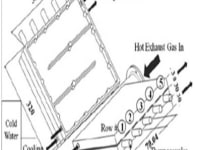INTRODUCTION
This paper deals with one of the key challenges in designing the next generation future hybrid vehicles with Efficient Waste Heat Recovery System.
Much of the fuel energy in an internal combustion engine is lost as heat, mainly through hot exhaust gas. The high energy losses, and high temperatures of the exhaust gas, provide favorable conditions for applying a waste-heat recovery system.
Typical internal combustion engines lose about 75% of the fuel energy through the engine coolant, exhaust and surface radiation. Most of the heat generated comes from converting the chemical energy in the fuel to mechanical energy and in turn thermal energy is produced. In general, thermal energy is underutilized and thus wasted. This project deals with the analysis of using thermoelectric generators and heat pipes in auto motives for efficient waste heat recovery system used again by the system to increase fuel efficiency of the vehicles.
Before a new car is released to the market, testing is undertaken to ensure it meets the latest emissions regulations. The regulations differ from country to country, but they are always getting more stringent. The CO2 emissions of a car are proportional to its fuel consumption. Therefore, to meet these tightening regulations, car companies must reduce the fuel consumption of their cars. Current ICEs are on average approximately 25% efficient under typical driving conditions (i.e.: European driving cycle) but can range from 20% to 45% depending on the engine type and operating conditions. The remaining 55%–80% will be wasted as heat in both the coolant and the exhaust gases. A waste heat recovery system has the potential to convert some of this waste heat into electricity and consequently reduce the fuel consumption of the car by reducing the load on the car alternator. Heat pipes and TEGs could be used in conjunction for use in a waste heat recovery system. Their compact size and solid state design make them ideal for automotive applications.
METHODOLOGY
TEG make use of what is known as the Seebeck effect .A TEG is made up of many elements of N type and P type semiconductor materials which are connected electrically in series but thermally in parallel. When one side of the TEG is heated and the other side cooled, a voltage is generated. The voltage generation means there are applications for these TEGs to generate electricity where temperature differences are present. Their efficiency is typically 5% and they can generate electricity where temperature differences are present. Their efficiency is typically 5% and they can generate power from any temperature difference. A TEG operates at approximately 20% of the Carnot efficiency over a wide temperature range.
Compared to other waste heat recovery technologies, the use of TEGs in a waste heat recovery system has many desirable attributes such as silence, small size, scalability and durability. Their key attribute is that they have no moving parts and and no chemical reactions therefore there is little maintenance required due to wear and corrosion.
Like this entry?
-
About the Entrant
- Name:Manivannan A
- Type of entry:individual
- Patent status:none








